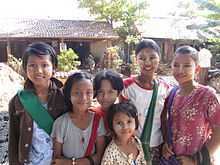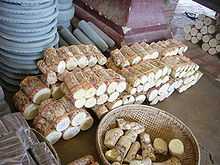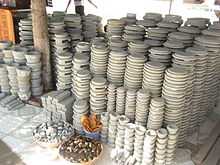Thanaka

Thanaka (Burmese: သနပ်ခါး; MLCTS: sa. nap hka:; pronounced: [θənəkʰá], also spelt thanakha) is a yellowish-white cosmetic paste made from ground bark. It is a distinctive feature of Myanmar (formerly Burma) seen commonly applied to the face and sometimes the arms of women and girls and to a lesser extent men and boys.[1][2][3] The use of thanaka has also spread to neighboring countries including Thailand.[2][3][4]
History
The earliest literary reference to thanaka is in a 14th-century poem written by Mon-speaking King Razadarit's consort.[5] Mentions of thanaka also exist in the 15th century literary works of Burmese monk-poet Shin Maharatthasara (1486-1529).[5]
Source and preparation


The wood of several trees may be used to produce thanaka cream; these trees grow abundantly in central Myanmar. They include principally Murraya spp. (thanaka) [2] but also Limonia acidissima (theethee or wood apple).[6] The two most popular are Shwebo thanaka from Sagaing Division and Shinmadaung thanaka from Magwe Division. A more recent contender sold as a paste is Taunggyi Maukme thanaka from southern Shan State. Thanaka trees are perennials, and a tree must be at least 35 years old before it is considered mature enough to yield good-quality cuttings. Thanaka in its natural state is sold as small logs individually or in bundles, but nowadays also available as a paste or in powder form.
Thanaka cream is made by grinding the bark, wood, or roots[2] of a thanaka tree with a small amount water[6] on a circular stone slab called kyauk pyin[4] which has a channel round the rim for the water to drain into.
Application, style and properties
Thanaka cream has been used by Burmese women for over 2000 years.[4] It has a fragrant scent somewhat similar to sandalwood.[2][7] The creamy paste is applied to the face in attractive designs, the most common form being a circular patch on each cheek, sometimes made stripey with the fingers known as thanaka bè gya, or patterned in the shape of a leaf, often also highlighting the bridge of the nose with it at the same time.[4] It may be applied from head to toe (thanaka chi zoun gaung zoun). Apart from cosmetic beauty, thanaka also gives a cooling sensation and provides protection from sunburn.[1] It is believed to help remove acne and promote smooth skin.[4] It is also an anti-fungal.[2] The active ingredients of thanaka are courmarin and marmesin.[8]
-
Market stall keeper wearing thanaka, Mandalay
-
Market children with thanaka, Mandalay
-
Thanaka seller at Kaunghmudaw Pagoda, Sagaing
-
A Karen child (an ethnic group in Burma and Thailand) with Thanaka on her face.
Notes
- ↑ 1.0 1.1 Streissguth, Thomas (2007). Myanmar in Pictures. Twenty-First Century ISBN 0-8225-7146-3. pp. 44, 73. Retrieved 2008-01-21.
- ↑ 2.0 2.1 2.2 2.3 2.4 2.5 Mabberley, D J (1997). The Plant-Book: A Portable Dictionary of the Vascular Plants. Cambridge University Press ISBN 0-521-41421-0. p. 470. Retrieved 2008-01-21.
- ↑ 3.0 3.1 Kemp, Charles & Lance Andrew Rasbridge (2004). Refugee and Immigrant Health: A Handbook for Health Professionals. Cambridge University Press ISBN 0-521-53560-3. p. 98. Retrieved 2008-01-21.
- ↑ 4.0 4.1 4.2 4.3 4.4 Moe, J. "Thanaka withstands the tests of time". Mizzima News, 17 September 2008. Retrieved 2008-12-06.
- ↑ 5.0 5.1 Yeni (5 August 2011). "Beauty That’s More Than Skin Deep". The Irrawaddy. Retrieved 7 August 2011.
- ↑ 6.0 6.1 Köllner, Helmut & Axel Bruns (1998). Myanmar (Burma). Hunter Publishing ISBN 3-88618-415-3. p. 18. Retrieved 2008-01-21.
- ↑ Baker, William & Ira Bruce Nadel (2004). Redefining the Modern. Fairleigh Dickinson University Press ISBN 0-8386-4013-3. p. 24. Retrieved 2008-01-21.
- ↑ http://notwithoutmylipstick.com/2013/08/22/thanaka/
External links
- Thanat-kha by May May Aung
- Myanma Thanakha
- Burmese thanaka faces TrekEarth photos
- Thanaka Flickr photos
| |||||||||||||||||||||||||||||



